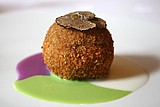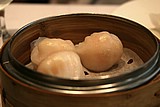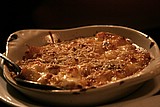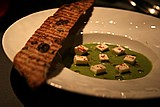Home |
Restaurants by City
|
Food Photography |
Archive | Philosophy |
![]()
Right now we are eating in Seattle, Washington.
|
Wednesday
2006
Permalink
|
Sant Pau, Tokyo, Japan, tasted on December 15, 2005 Given my love for foreign cuisines interpreted in Tokyo it shouldn't surprise you that I was up for Spanish food. Sant Pau is a famous restaurant in Barcelona, Spain and part of the Relais Chateaux high end restaurant and hotel association. I didn't realize that they were part of Relais Chateaux before I went. On the one hand that pretty much guarantees a particular type of high end dining experience. On the other hand, sometimes you wonder if the definition might be too narrow. Either way I was open minded and excited about the meal. European transplant it might be, I think the influence of Japan is hard to ignore no matter what tradition you bring with you. I was escorted from the front door up to the dining room. Passing by the entire Spanish ham waiting to be carved was a positive omen. It was like seeing some sort of symbol of good fortune hanging over the door of an environment you're about to enter. In other words, Serrano ham in the house means good things are coming. Sant Aniol sparkling water graced my sunny window-side table in the beautifully designed room. The water was filled with super fine but sharp carbonation. I loved it. The dining room was gorgeous and everything was covered in wood and leather but in an understated way. The breadsticks were super crispy and crunchy. At first I thought they might have been cheese sticks from the looks of them. Bread, olive oil, and salt also helped as I waited for my first course. That said, I didn't have to wait long for the meal to start off. Monkfish with Cream of Turnip and Basil Foam started things off. It was a warm and soft "bite" with an al dente veggie dice and a creamy turnip foundational sauce. This was comforting and savory and slightly salty in a good way. Next up was Quail in Vinaigrette with Almonds and Raisins. This wasn't quite as flavorful as the first dish. And the bone made it hard to eat especially as they had taken my finger towel. Don't worry, I found a way. I was really excited by the Confit and Brandade of Cod Mixed with Cream. The dish was beautiful and I always love it when a soup or sauce is applied tableside. There's just a freshness about the experience. There was also a crispy black sausage plane wrapped around a pate. The pate was also made from the from sausage. There was also a gelee of parsley inside a gelee of piquillo pepper. The soup poured into the dish was a garlic and bread soup. As refined as this dish was I could imagine eating it by a warm fire on a cold night. The three items each had starring roles but didn't compete with each other. There was harmony between the confit which had a buttery and subtle cod flavor, and the sausage which was hearty and had deep flavors but in a small and unobtrusive way. And then there was the soup itself which bound the other flavors together. The brandade and gelees contributed color and texture but couldn't hold up against the other flavors. That said, the dish was excellent. After the cod came the Kinki with Puree of Zucchini and Punpkin with Fresh Tomato Foam and Bean Sprouts. Two sauces graced the plate. One was a light colored reduction based on fish bones. The second was the same with the addition of raspberry. As I finished he dish I received Ceylon tea with raspberry with a fish stock base used instead of water. This dish was a journey through disciplined but gentle alternating warm and bright tones on a soft textured bed. There was surprising acidity (subtle though) in the dish even before I hit the raspberry accented reduction. Really a marvel. The kitchen at Sant Pau is filled with painters. The tea was interesting if not enjoyable. It didn't add anything for me. It wasn't bad per se but wasn't exactly enjoyable either. This next dish was a superstar - Cauliflower Viole, Potato and Broccoli Puree, Pork and Veal Truffle with Font de Veau. Aside from the sauces, this entire concoction was deep fried. While I usually don't talk tons about presentation, this may have been the most beautiful dish I've ever eaten. They aren't just painters in the kitchen, they are master painters. Wow! When I cut into the ball and the the deep red/brown veal sauce started flowing I almost lost it. The outside was crusty and perfectly deep-fried. The meat was rare and delicious. The sauce was overwhelmingly tasty with that bright wine-like savoriness and depth that only comes from a very well made veal stock. I almost forgot to really linger and taste the bites properly as the dish was so distractingly beautiful as I ate it. The vegetable purees were light and creamy and provided a lovely base for the dish. Did I mention the sliver of black truffle perched atop the dish? Dessert was a 70 percent Ganache with Milk chocolate mousse and Lime and Pumpkin Seeds with Salt and Milk Ice Cream. The salt and acid spikes of the lime and seeds with their pumpkin seed overtones made the dish special. These flavor spikes were like fireworks on the pure vista of the velvet chocolate and the smooth ice cream. The pistachio and chocolate petit fours were excellent as well. After dinner I lingered briefly outside looking through the glass into the open kitchen. Much to my surprise one of the chefs came out to offer me a homemade lollipop and a tour inside. I was running off to the airport as this was the last meal of my trip to Asia, but I couldn't help myself and got to check out the kitchen for a bit before I took off. The dual clocks showing the time in Tokyo and Barcelona were a nice representation of the Spanish food brought to life in Tokyo with local ingredients and aesthetics. Really beautiful.
|
|||
Our Sponsors
Free Car Listings Hot Tubs Stools Saunas Bar Stools - Calendar and Event Schedules - Food Events and Calendars - Wine Events and Calendars - Digital Photography Resources - Software for Advertisers - Jewish Gifts and Judaica - Howard Stern Podcast - ponytailed blogger Jonathan Schwartz

Browse tastingmenu
Home |
Restaurants by City X |
Food Photography |
Archive | Philosophy |
![]()
Free eBooks: All About Apples
| Autumn Omakase
More:
Discussion |
Cool Food T-Shirts |
Ingredients
| Markets |
Recipes
Search |
Blog FAQ |
Other
Blogs
Best of tastingmenu
|
City View
Entry: July 6, 2006 |
Blue Plate
Entry: June 19, 2006 |
L'Atelier de Joël Robuchon
Entry: July 18, 2006 |
Browse by City
Boston | Chicago | Houston | Las Vegas | Los Angeles | Maui | New York | Philadelphia | Portland | San Francisco | Seattle | Toronto | Utah | Vancouver | Washington D.C.
Bangkok | Beijing | Hong Kong | Seoul | Tokyo
Amsterdam | Berlin | Italy | London | Madrid | Paris | Vienna
Browse by Month
2006
2005
2004
2003
2002
2001
Comments, questions, or feedback:
info / at / tastingmenu / dot / com
All pages Copyright (c) 2001-2006 tastingmenu.com
Last modified 01/30/07.





